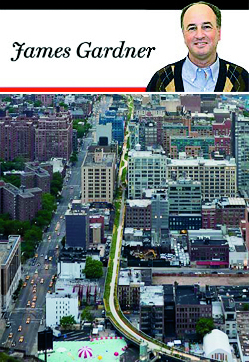Trending
High Line may be a glorified promenade but it provides an intimate, interesting experience

The High Line (courtesy of Architectural Record)
Phase 2 of the High Line opened yesterday, and it is a great advance on the already substantial achievement of Phase 1. While the latter, which opened in 2009, two years earlier to the day, stretched from Gansevoort to 20th streets, the new extension takes us half a mile further, all the way up to 30th Street. Much is the same and much is different.
The Mod aesthetic favored by the architecture firm Diller Scofidio + Renfro is exemplified
in both cases by the grayish concrete pavers flanked by plantings and relieved by wooden
benches in odd shapes and a variety of coves. But while the earlier and more southern stage
generally stands apart from the large neighboring buildings, even as it passes under them, the
newly unveiled segment skirts so close to the generally diminutive buildings in its stretch that
the idle stroller can peer impertinently into the windows of the inhabitants. For this reason,
among others, the experience of walking the half mile in question feels far more intimate and
interesting.
Though the High Line styles itself as a park, it is really a glorified promenade. That said, it has
areas of green where people can sunbathe and do so, to all appearances, in far greater comfort
than at any point in the more southerly section.
Earlier in the week, the mayor’s office released some data claiming that, while the High Line
has thus far cost $110 million, the amount it has generated for New York is nearly 20 times that
figure. As one enters the new park, this enthusiastic achievement seems entirely plausible. It is
like the Under-Nile of legend which, overflowing its banks, brings untold abundance to anyone
fortunate enough to live near it. Luxury stores and trending restaurants suddenly sprout up near
it, while venders, artists and buskers are coming out of the woodwork and prospering mightily.
But just as no one these days can look at a Van Gogh painting without thinking of how much it
would cost at auction, so the conversation of the strollers is peppered with comments about much
the property values of pre-existing buildings and new condominiums have increased as a result of the High Line. Clearly something like a real
estate reflex has lodged itself within the collective psyche of the citizens of New York. Let us
relish in passing that the very thing that 10 years ago was deemed a liability — a two-mile length
of rusting and useless metal — is the very thing that now has increased several times over all of
the properties in its vicinity.
When completed, Part 3 of the High Line, which swings sharply to the west and ends up in front
of the Javits Convention Center, will be very different from the two earlier phases. It is free of
pre-existent buildings and arrives almost at the water’s edge. But if the past is any indication,
before too long, developments will be trying to rise up all along its length.
James Gardner, formerly the architecture critic of the New York Sun, writes on the visual arts for
several publications.




